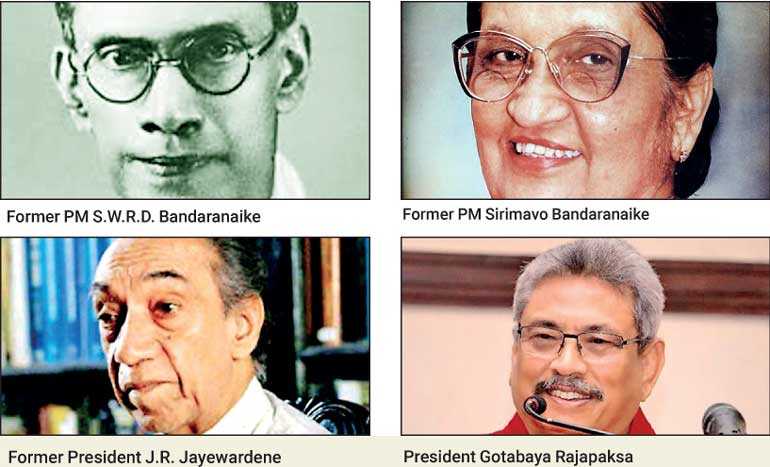Thursday Nov 21, 2024
Thursday Nov 21, 2024
Saturday, 8 May 2021 00:10 - - {{hitsCtrl.values.hits}}

 Sri Lanka’s foreign policy has traditionally been one of “learn and adapt,” having never inherited a fully-functioning Foreign Office at the time of Independence. Sri Lanka (or Ceylon as it was then known) was reliant on the British and the Commonwealth for exposure to foreign states. This is in stark contrast for the island nation who had a long history of playing an integral role in the trade route between China (and Asia) and the Middle East and Europe.
Sri Lanka’s foreign policy has traditionally been one of “learn and adapt,” having never inherited a fully-functioning Foreign Office at the time of Independence. Sri Lanka (or Ceylon as it was then known) was reliant on the British and the Commonwealth for exposure to foreign states. This is in stark contrast for the island nation who had a long history of playing an integral role in the trade route between China (and Asia) and the Middle East and Europe.
While the framework was being setup as early as 1947 it was only in 1955, at the Bandung Conference, that Sri Lanka embraced the spirit of international co-operation amongst new nations. This would eventually translate into the Non-Aligned Movement, of which Sri Lanka was one of the original members.
As the S.W.R.D. Bandaranaike administration pursued a non-aligned foreign policy, a salient feature was his eagerness to renegotiate the presence of British military bases in the country. In October 1957 the Royal Navy Base at Trincomalee was handed over to the Sri Lankan Government, while in November that year the Royal Air Force Base stationed at Katunayake was also handed over to his Government.
Speaking at the handing over ceremony, Bandaranaike stressed that these hand overs were not done “in the spirit of hostility” but out of necessity from a foreign policy of non-alignment. While Bandaranaike went to great lengths to reassure Britain and the United States of America that his Government would not take sides in the Cold War, relations with the West certainly faced a downward trajectory. The question that arises is whether Sri Lanka’s policy of non-alignment under Bandaranaike was what its name suggested or whether it would be more aptly considered a policy of “anti-Western aggression and expansion”.
He was quick to welcome the nationalisation of the Suez Canal by the Egyptian Authorities, and subsequently advocate the withdrawal of French, Israeli and British troops from the zone. However, such condemnation or comment was absent in 1959 when China annexed Tibet. In fact, his opinion on the matter was that this was an internal affair of China’s and as such warranted no international commentary.
This policy of anti-imperialism and anti-Western expansion was carried forth by his wife and successor, Sirimavo Bandaranaike. The family’s rule of the country, and the Sri Lanka Freedom Party, left a mark on Leftist politics in the country as one of being pro-Asian regional bloc, while slowly yet surely gravitating Sri Lanka away from the influences of the old Colonial powers.
With the centre-right United National Party enjoying a 17-year rule from 1977, coupled with the opening of the economy, Sri Lanka underwent a radical shift in foreign policy. Having endured several years of a closed economy, Sri Lanka’s foreign policy was more closely in-sync with India, the Soviet Union and China.
While maintaining relations with the US and the European powers, Sri Lanka’s closed economy failed to endear us to those powers. It was under the previous Bandaranaike administration, which saw widescale nationalisation, that touched on American and British sensitivities. The threat to foreign business interests in the country, coupled with increased engagement with Socialist and Communist states, had left a bad taste in the mouth of these countries.
The focused efforts of the J.R. Jayewardene Government to undo the economic damage caused by the previous regime’s economic policies saw the country turn its attention towards the powerhouses in Europe and the US. While Jayewardene’s Government continued to adhere to a non-aligned policy, in regards their economic policy efforts were made to see a greater balance struck between the East and West. The UNP, who has boasted of having first established relations with China, in 1950, tested their ability when they tried to balance the emergence of a new China alongside renewing relations with the West.
One of the first steps taken by the new administration was the incorporation of the Greater Colombo Economic Commission to attract private investments. On the back of widescale economic restructuring foreign aid and investments began to pour into the country from all avenues.
Having championed Japan’s cause at the Japan Peace Treaty Conference in San Francisco in 1951 by waiving reparations on behalf of Sri Lanka, Jayewardene had endeared the country to them. Their gratitude was repaid through increased investment and financial assistance in Sri Lanka’s shipping industry, health sector, food production and media and communications. Similarly, the opening of the economy and a gradual shift away from the Socialist bloc saw the 14th Sri Lanka Aid Group Meeting in Paris in 1978 pledge up to Rs. 6 billion for development projects.
While Jayawardena and the UNP continued to pursue a global “South-South dialogue and engagement”, the shift towards greater economic cooperation with the “global North” was given pride of place. Fast forward 44 years and Sri Lanka’s foreign policy no longer has the appearance of non-alignment as has been the salient characteristics post-Independence.
Under the present Government Sri Lanka’s foreign policy has entered unchartered territory. Traditionally having been considered the quintessential “younger brother” to India, the country’s path forward has been influenced by the sub-Continental giant. With the 30-year Civil War ending in 2009, India was arguably slow to engage with the post-war Rajapaksa administration. China, having enjoyed close relations with the Sri Lanka Freedom Party, did not scoff at the opportunity to make their mark in the nation. A slew of investments into infrastructural projects in the country saw China expand their influence in the country.
By the end of 2019 Sri Lanka’s debt to China stood at Rs. 986 billion ($ 5.4 billion), which is matched only by Japan who is the country’s oldest development partner and lender. However, since 2019 the new Government has obtained in excess of Rs. 300 billion ($ 1.5 billion) in loans from China. While at the same time closing the door on a joint investment in the Colombo East Terminal Container project between Sri Lanka-Japan-India. Similarly, Japan has also been pushed aside in the development of the Light Rail Transport system which was another investment project previously agreed upon between the two nations.
Since the election of the new Parliament last year, China has sent two high-powered delegations to the country. In October last year Yang Jiechi, Director of China’s Central Committee’s Foreign Affairs Commission, visited the country. His trip was followed up last month by a visit by China’s Minister of Defence, Wei Fenghe. According to media reports, by a visit by China’s Foreign Minister Wang Yi is scheduled for next month.
While the visits of high-level delegations have been news-worthy, the discussions and agreements signed during these occasions have been absent from public view. In fact, reporting on the visit of the Minister of Defence was largely absent from local media, with it being relegated to news alerts and official communique. With Sri Lanka’s apparent shift towards China, at the expense of their allies in India and Japan, questions are now being raised as to whether the present Government has abandoned the widely accepted policy of non-alignment.
China has fast become, courtesy of former US President Donald Trump’s anti-China rhetoric, public enemy No. 1 on the international stage. While the post-Trump administration is attempting to slowly walk-back some of the more inflammatory stances of the US, the Asian giant has found itself isolated amongst the powerhouses. Recognising their need for the creation of a new bloc within Asia, China has set about cultivating allies through financial assistance and infrastructural projects associated with the ambitious Belt & Road Initiative. The result has been a gradual turn towards China by the “Tiger” economies of Asia and emerging markets in Africa.
However, the ability of these nations to balance relations with China and the old powers of the US and Europe have allowed them to avoid the spotlight in the 21st Century Cold War. In regards Sri Lanka and the Rajapaksa administration, this does not seem to be the case. While the 2015-2019 Government was able to strike a balance between China, India and the West, the present administration seems either incapable or unwilling to replicate this success. The rebuttal of the United Nations Human Rights Council in Geneva saw the Government once again shunned on the international stage. Their refusal to proceed with a tripartite agreement involving India and Japan led to a chilling of relations with two of the country’s oldest allies. While their noticeable shift into China’s sphere of influence through the continued arrivals of high-level delegations has raised eyebrows around the table.
A return to pre-1977 Sri Lankan foreign policy of pro-Asian engagement will certainly not be a black mark on this administration. However, the successes of such a policy were reliant on the country enjoying relations with a host of nations beyond China and the Soviet Union. Under this current trajectory, Sri Lanka seems destined to bypass the rest of Asia and settle itself firmly under the umbrella of China. Whether this will pay dividends for the country remains to be seen. However, as China remains on the outside, it would not be ill-advised to continue to pursue other avenues alongside the one they seem fixed on.